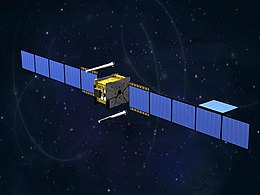Skynet 5B
 | |
| Mission type | Military communications |
|---|---|
| Operator | Paradigm Secure Communications EADS Astrium On behalf of British Ministry of Defence |
| COSPAR ID | 2007-056B |
| SATCAT no. | 32294 |
| Mission duration | 15 years |
| Spacecraft properties | |
| Bus | Eurostar 3000S |
| Manufacturer | Astrium |
| Launch mass | 4,635 kilograms (10,218 lb) |
| Start of mission | |
| Launch date | 14 November 2007, 22:06 UTC |
| Rocket | Ariane 5ECA V179 |
| Launch site | Kourou ELA-3 |
| Contractor | Arianespace |
| Orbital parameters | |
| Reference system | Geocentric |
| Regime | Geostationary |
| Longitude | 25° East |
Skynet 5B is a military communications satellite operated by Astrium Services, formerly Paradigm Secure Communications, on behalf of the British Ministry of Defence. It was the second of four Skynet 5 satellites to be launched.
Spacecraft
[edit]The Skynet 5B spacecraft is a Eurostar 3000S satellite, constructed by Astrium. At launch it had a mass of approximately 4,635 kilograms (10,218 lb), with a design life of 15 years.[1] Its 34-metre (112 ft) solar arrays will generate a minimum of 6 kilowatts[2] to power its UHF and X-band communications systems.
The Skynet 5 constellation was originally intended to consist of two satellites, the other of which, Skynet 5A, was launched earlier in 2007. By the time of Skynet 5B's launch, a decision had been made to launch the backup spacecraft, Skynet 5C, as an on-orbit spare; this was launched in 2008. Skynet 5D was ordered to replace the backup, however this too was launched in 2012. Skynet 5 replaced the earlier Skynet 4 system.[3]
Launch
[edit]Skynet 5B was launched by an Ariane 5ECA carrier rocket flying from ELA-3 at Kourou. The launch occurred at 22:06 UTC on 14 November 2007.[4][5] Star One C1 was launched aboard the same carrier rocket; Skynet 5B was mounted atop a Sylda 5 adaptor, with Star One C1 attached to the upper stage underneath the Sylda. Skynet 5B was the first of the two spacecraft to separate from the carrier rocket.[2]
Orbit
[edit]The launch placed Skynet 5B into a 250 by 35,786 kilometres (155 by 22,236 mi) geosynchronous transfer orbit with 6 degrees of inclination.[2][6] The satellite used its apogee motor to raise itself into geostationary orbit.[5] It is located at a longitude of 53° East, in an orbit with a perigee of 35,572 kilometres (22,103 mi), an apogee of 35,867 kilometres (22,287 mi), and 0 degrees inclination.[7]
References
[edit]- ^ Krebs, Gunter. "Skynet 5A, 5B, 5C, 5D". Gunter's Space Page. Retrieved 28 January 2013.
- ^ a b c "A dual launch for Brazil and the British MoD" (PDF). Arianespace. 9 November 2007. Archived from the original (PDF) on 29 October 2013. Retrieved 28 January 2013.
- ^ "Skynet 5 Satellite Communications". British Army. Archived from the original on 20 September 2012. Retrieved 28 January 2013.
- ^ Amos, Jonathan (14 November 2007). "UK military spacecraft launched". BBC News. Retrieved 28 January 2013.
- ^ a b Bergin, Chris (14 November 2007). "Ariane 5 ECA launches with Skynet 5B and Star One C1". NASASpaceflight.com. Retrieved 28 January 2013.
- ^ Clark, Stephen (14 November 2007). "Ariane 5 launches British and Brazilian satellites". Spaceflight Now. Retrieved 28 January 2013.
- ^ McDowell, Jonathan. "Satellite Catalog". Jonathan's Space Page. Retrieved 28 January 2013.
